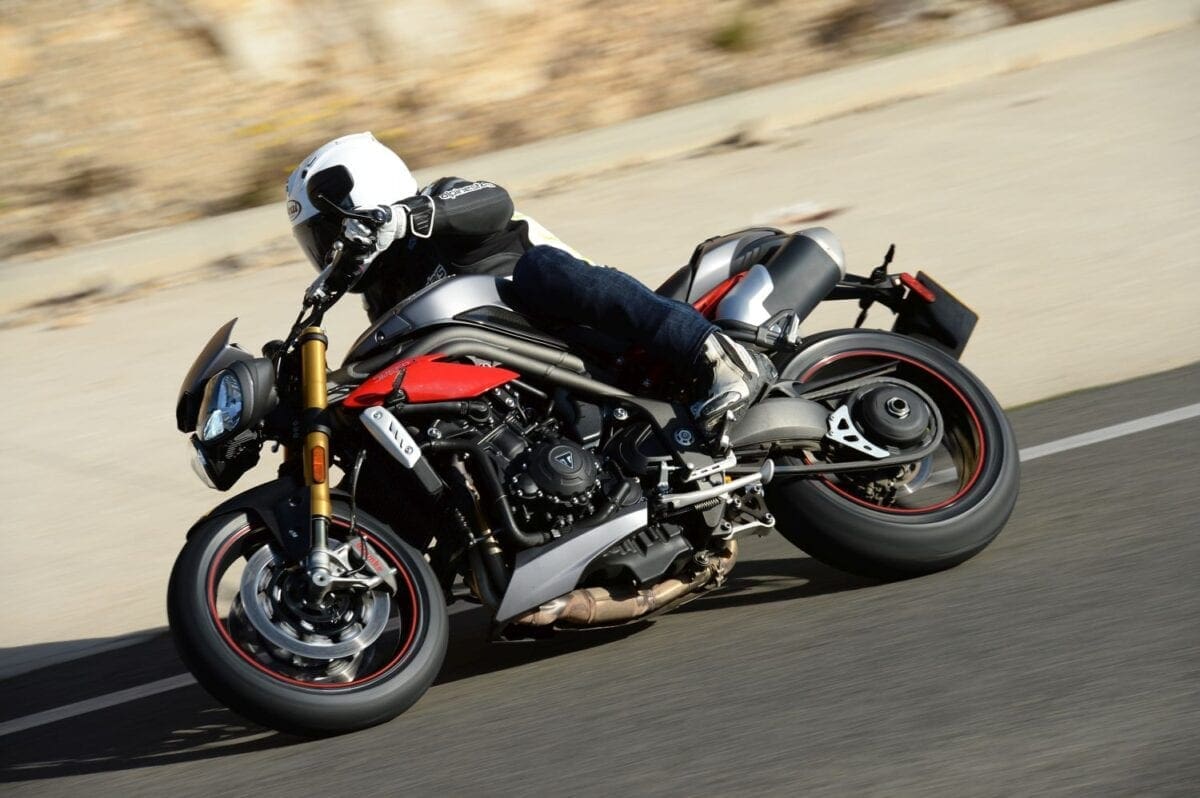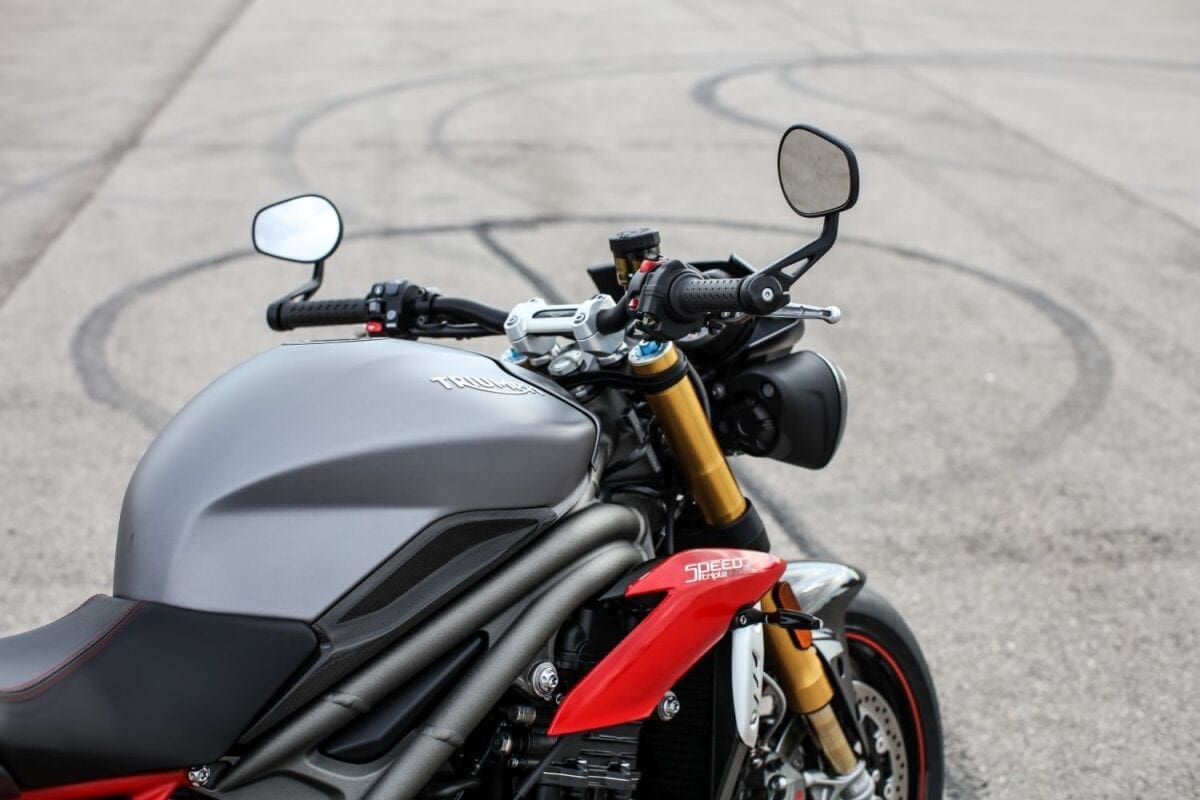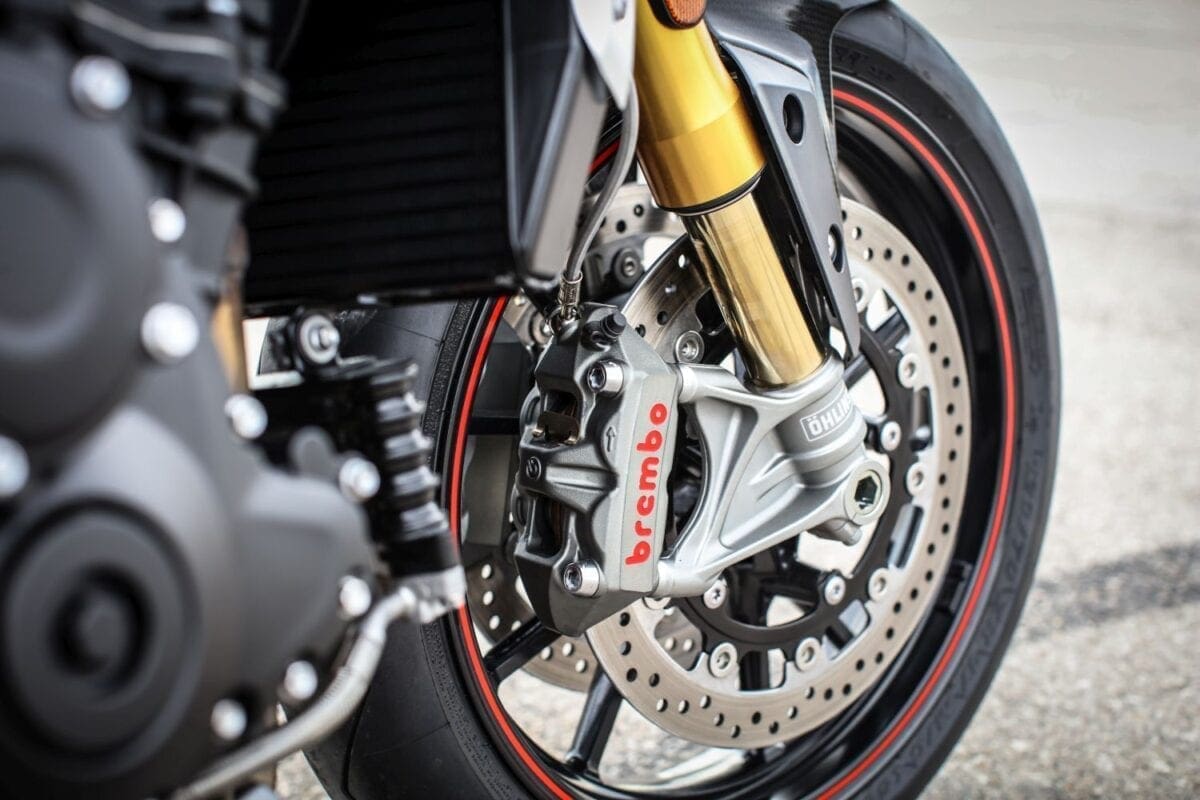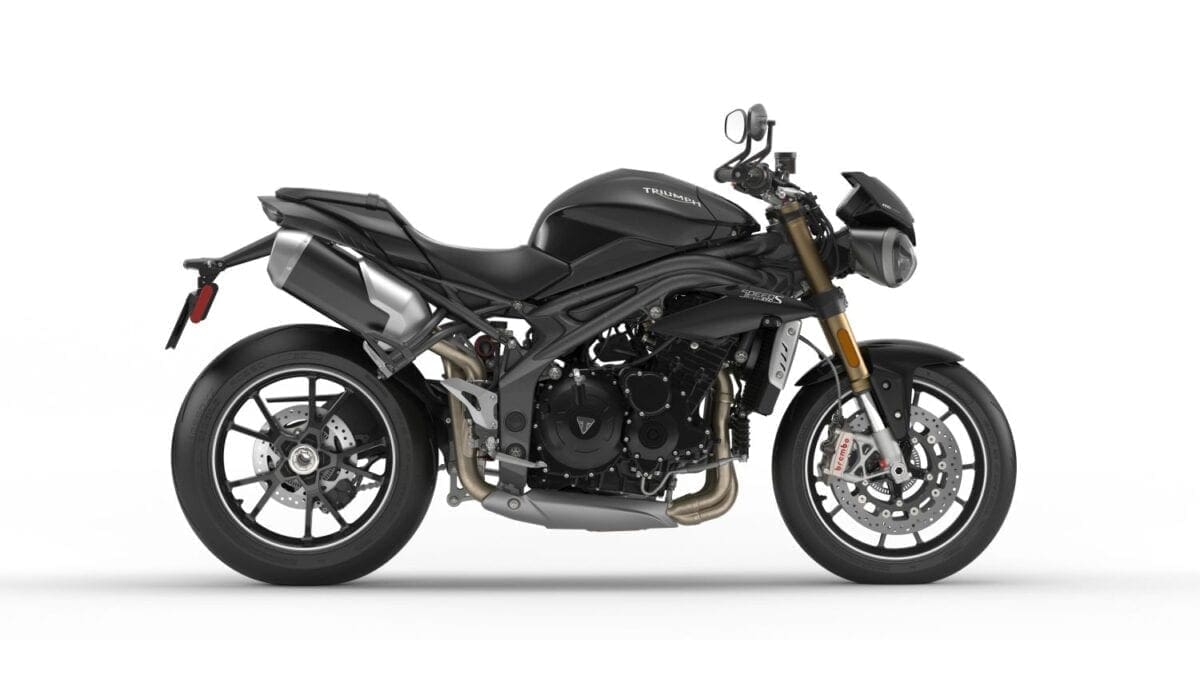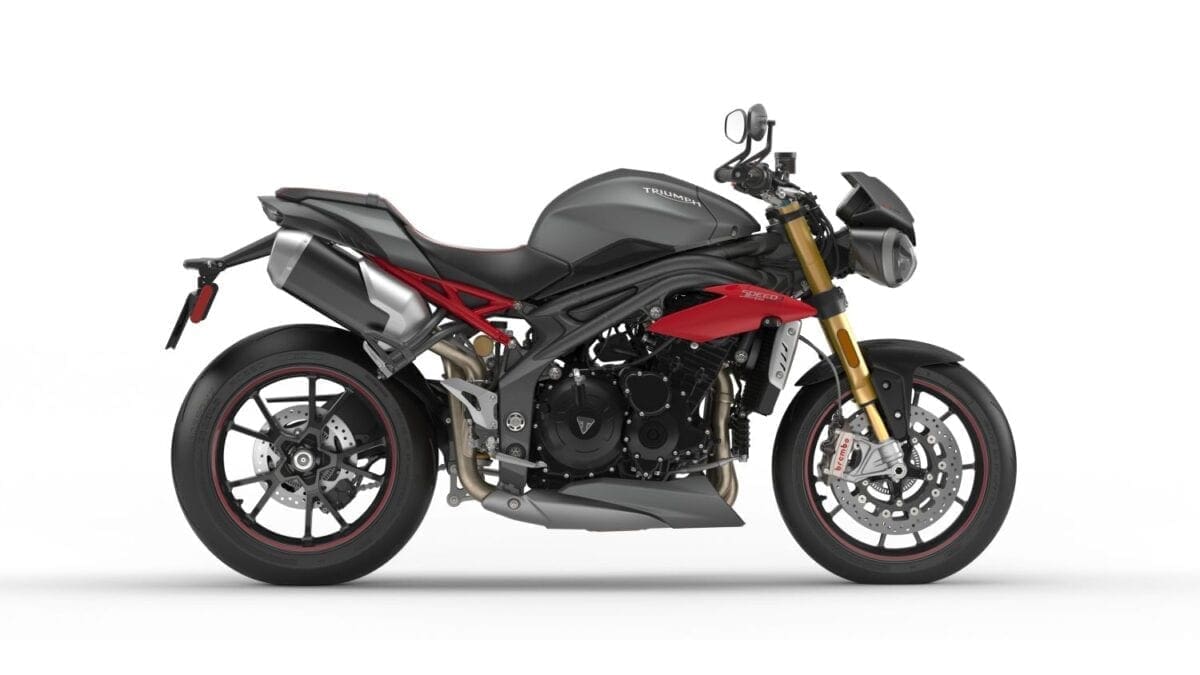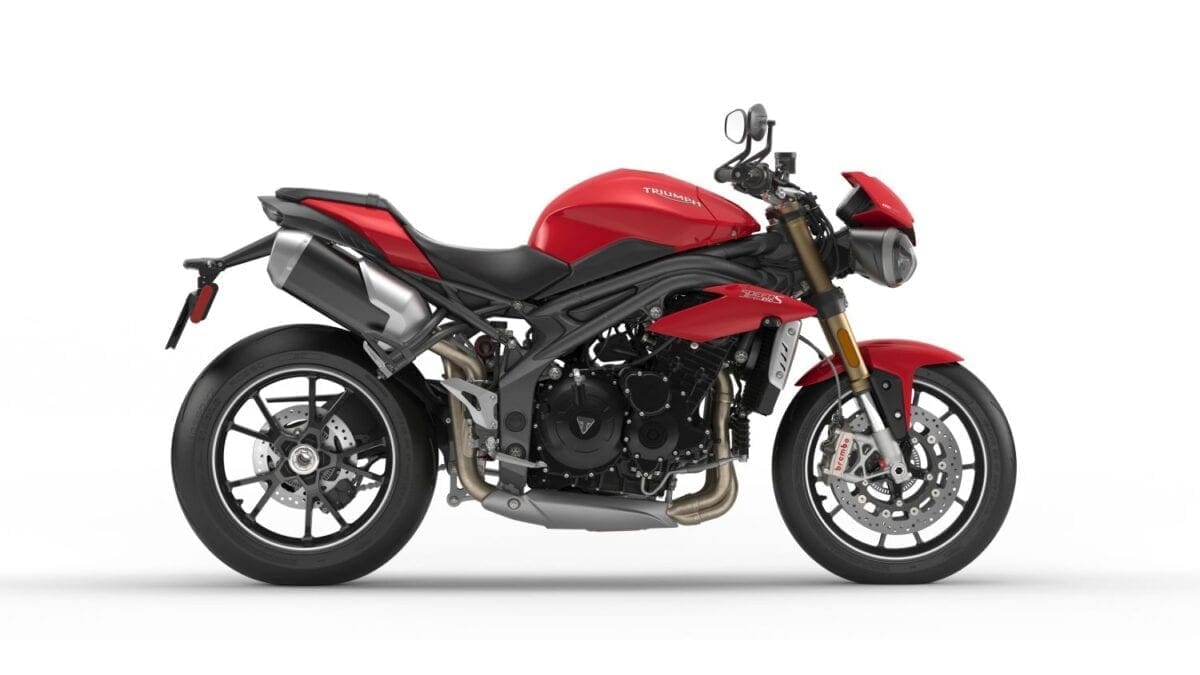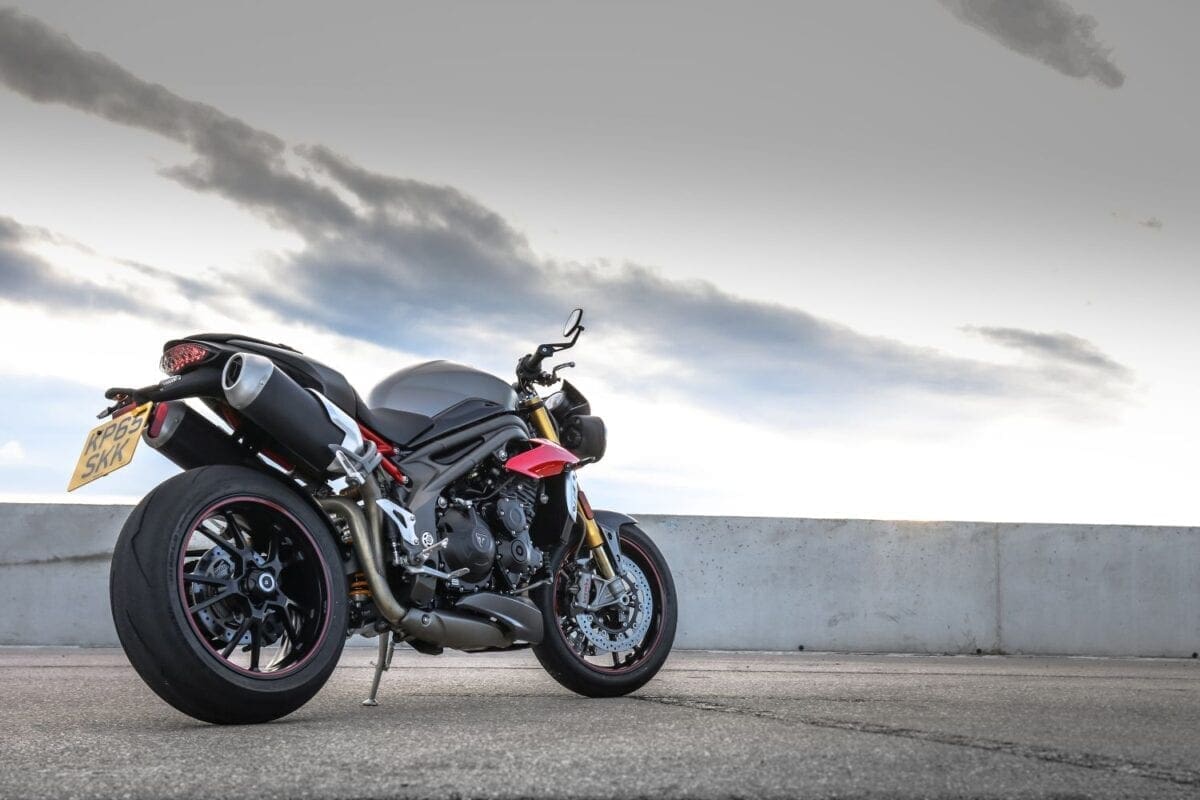2016 Triumph Speed Triple World Launch review
Tested by: Bruce Wilson
Photography by: Triumph
Enjoy everything More Bikes by reading the MoreBikes monthly newspaper. Click here to subscribe, or Read FREE Online.
When Triumph launched the original Speed Triple T309 back in 1994, little could it have dreamt of the success which awaited the Hinckley-based brand’s most iconic family.
Now on its sixth incarnation, the popular performance naked is set to enhance its global desirability once again owing to a comprehensive make-over. With a strong focus on achieving more power, more sophistication and more attitude, everything about the new Speed Triple 1050S, and the higher specification 1050R, has been cranked up another level.
The new models are instantly recognisable owing to much sleeker styling, with a notably lower and more compact stance. The 15.5 litre tank is narrower and shorter – losing two litres as a direct consequence – whilst the front of the bike has been completely recrafted with a more contemporary design of twin headlights, being bordered by a factory fitted plastic flyscreen, unlike on its predecessor. Contrary to an ever changing trend to remove under seat exhausts for better weight distribution, Triumph has kept with tradition and produced an all-new shaped and much lighter style of dual end can for the model. To meet Euro 4 standards, the entire exhaust system had to be completely remastered, with a larger bore of pipe and a counterintuitive design of headers aiding exhaust gas flow by 70%. Simultaneously, the factory capitalised on the opportunity to tune the exhaust note for a meatier sound, as well as added performance.
Although peak horse power for the new models is only 5bhp more than it was on the outgoing version (up from 133 to 138bhp), the engine is massively different, with 104 changes to note. Everything from the piston design to the intake ports, fuelling system to the gear linkages are different, with the combined gains seeing a five per cent increase in mid-range torque. Ridiculous horsepower figures weren’t the number one goal behind the motor’s drastic remodelling, with a greater emphasis being placed on class leading driveability throughout the entire rev range. More instant power was also on the wish list, being achieved in part by the fitment of a lighter crank and more advanced throttle bodies.
The frame within which the engine sits has remained unchanged. Speaking with one of Triumph’s development riders on the models’ launch near Barcelona, he explained, ‘it would have been very hard to have bettered the performance of the old frame, which is well known for its agility, stability and feedback’. Not even the headstock angle has been altered, with rake and trail figures remaining the same as they were on the old 1050. What is new in the handling department are improved suspension units. The 1050S is fitted with road-focussed fully adjustable Showa units front and rear, whilst the £1300 pricier 1050R gets track capable Ohlins suspension. The R also gets carbon fibre tank infills and a mudguard, a colour coded belly pan, billet handlebar clamps and risers, plus swingarm pivot covers and a fancier rear wheel finisher. But these differences aside, plus a few colour options, the S and R versions are really quite similar. They even share the same electronics packages, both benefiting from the same ECU as used on the Daytona 675R.
Triumph’s had a bit of catching up to do on the gizmo front, but it’s impossible to knock the availability of tech found on the S and R. For the first time, the Speed Triples come as standard with five different riding modes, three different throttle maps, three different ABS options and four levels of traction control. If Triumph wasn’t in the 21st century before, they certainly are now.
The bikes we got to test on the launch were all 1050R versions, sporting the signature red subframes and pinstripe rims to denote their pedigree. Aesthetically speaking, my first impressions of the models in the flesh were very favourable. The whole package has moved on, with a much more flowing and aggressive guise; the front of the bike sitting lower and the rear-end jacked-up. The beautifully sculpted and 20mm narrower rider’s seat is mirrored in red-stitched detail by the independent pillion seat, housed on top off a much less bulky rear seat unit. The high-rise exhaust cans also looked great at the rear and I particularly liked the new air intake at the front of the bike, plus the stylish and practical bar-end mirrors.
To sit on, the Triumph felt spacious and comfortable, with the revised ergonomics meaning you now sit slightly more forward and can plant your feet firmer on the ground – owing to the lesser saddle width. The raised bars were placed an easy reach away, locking my 5’ 9” frame into an upright riding position. The clocks on the new 1050R looked very similar to what’s come before, sporting an analogue rev counter on the right and a digital display area to the left. By pressing at an ‘info’ button on the left bar I could toggle my way between an abundance of info, including trip and average mpg. The mode button, on the same cluster, allows you to dive into your bike’s setup, displayed on the dash as Rain, Road, Sport, Track or Rider. Whilst the former selections give you predetermined set-up positions for ABS, throttle map and traction control, the ‘Rider’ mode is completely customisable.
Every time you switch your bike on it automatically reverts to ‘Road’ mode, which was the setting I used to kick off my 80-mile road test. It took a matter of metres to fall in love with the new engine, which seemed to pull even more effortlessly than the unit which came before it. The initial part of the ride was through a slow residential area, and despite travelling at just 30mph, sixth gear proved a great selection; the engine never struggling or hunting for more revs. A few round-a-bouts did provoke me to go down a few gears, giving me a clearer gauge of the new gearbox and the slipper clutch, which is also a fresh feature on the bike. Engagement through the gears was seamless and the clutch lever felt fantastically light to engage.
By the time we’d made it out onto some decent mountain twisties I was already smitten with the Triumph, but learning how well the bike cut it through the corners took things to that next level. Technically speaking this is no sports bike, but it handles as if it’s been made for the track, with its best virtue being its unflappably stable nature. You can be on and off the throttle mid-corner and still fail to upset its planted feel, which gives you loads of confidence.
As is the case on any naked, I was completely exposed during that initial road ride, but because of the comfy saddle and relaxed riding position I never once felt achy or anywhere near desperate to get off and have a leg stretch. In fact, I thought quite the opposite, desperately wishing away our lunch break before I got chance to put the 1050R through its paces on the Calafat race circuit. As far as tracks go, Calafat is very tight and technical, with lots of undulations and hard braking zones. It’s probably better suited to smaller capacity bikes, not 200kg-plus roadsters. Or, at least in theory.
Getting to open up the Triumph’s motor properly was a real treat, holding the throttle to the stop at every given opportunity. The power was so linear and the revs climbed so quickly that I often found myself hitting the limiter. As already mentioned, the gearbox was super smooth to shift through, but I did find myself lusting after a quickshifter on several occasions. They’ve become a staple feature on many performance nakeds, so it was a shame to find it didn’t come as standard on the 1050R – especially so because it does on the smaller capacity 675R Street Triple. Having got to grips with the circuit layout, my focused turned fully to assessing the electronics package on the bike. On all rider modes you still get the full 138bhp output, but the speed at which you can access it is governed by the throttle map. Earlier in the day I’d toggled through the options on the road and made a note of how much more lethargically the bike accelerated in rain and road settings than it did in sport and track.
At Calafat, I wanted to experience the Speed Triple in its rawest form, so ‘Track’ mode was my natural selection. It wasn’t just the speed with which the engine pulled that was different, there was also a severe difference in how interactive the traction control was, too. Calafat’s third corner is a long and building succession of right hand bends, in which you accelerate hard from second to fourth gear before reaching for the brakes. In anything other than Track mode the bike felt held back, albeit safe and planted. But asking for full gas at knee down angles with Track mode selected felt electrifying. The rear wheel was breaking away beneath me, but never sufficiently to cause any big moments; the traction control taking the edge out of any slides before they got too leery. It felt fantastic, as if I was riding on a fine line between control and a lack of. I only found its limits when leaning and driving over slippery, painted rumble strips, at which point it became quite ease to lose grip and slide the rear. But the informative frame meant that I was never caught out by a lack of grip.
Another technical gem was the ABS. the new Speed Triples are fitted with powerful Brembo Monobloc calipers and you can customise their ABS selection across Road, Track or Off positions. When in Track riding mode, Track ABS is automatically selected, meaning it’s near impossible to engage the system under braking on tarmac. In fact, I could make the rear wheel skip under hard braking without ever causing the ABS to notably kick in. But, likewise, nor was the front wheel locking. It’s a sophisticated system, which was first introduced and perfected by Triumph on its Daytona 675. You probably wouldn’t need it on the roads, but it was great to have it on track and not feel impeded by the ABS.
In all we got a whole hour to blast around Calafat and I was really impressed by the 1050R. The bike handled like a dream, offering great levels of agility and giving me loads of confidence. It proved the perfect track weapon, and yet such a great machine on the road, too.
From the way it looks to how it performs, Triumph has remastered this iconic machine and brought it right up-to-date with some of the best models in the performance naked category, arguably for a price that will leave some rival manufacturers feeling very nervous in 2016.
Specifications: Triumph Speed Triple 1050R / S
Engine: 1050cc, in-line triple, liquid-cooled
Peak power: 138bhp (103kW) @ 9500rpm / 138bhp (103kW) @ 9,500rpm
Peak torque: 82 ft-lbs (112Nm) @7850rpm / 82 ft-lbs (112Nm) @7850rpm
Transmission: 6 speed / 6 speed
Final drive: Chain / Chain
Frame: Aluminium twin spar / Aluminium twin spar
Wheels:
Front – 120/70/17 – 120/70/17
Rear – 190/55/17 – 190/55/17
Suspension:
Front – Öhlins 43mm NIX30 USD forks with adjustable preload, rebound and compression damping, 120mm travel /Showa 43 mm USD forks with adjustable preload, rebound and compression damping, 120mm travel
Rear – Öhlins TTX36 twin tube monoshock with adjustable preload, rebound and compression damping, 130mm rear wheel travel / Showa monoshock with adjustable preload, rebound and compression damping, 130mm rear wheel travel
Wheelbase: 1435mm / 1435mm
Dry weight: 192kg / 192kg
Fuel capacity: 15.5 litres / 15.5 litres
Seat height: 825mm / 825mm
Price: £11,500 OTR / £10,200 OTR
Contact: www.triumph.co.uk

